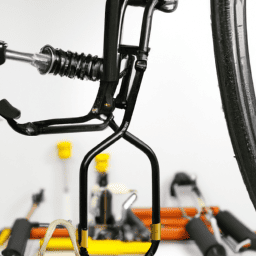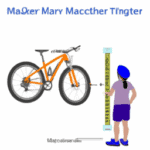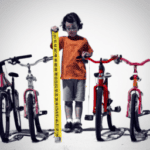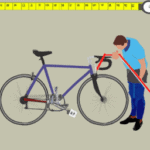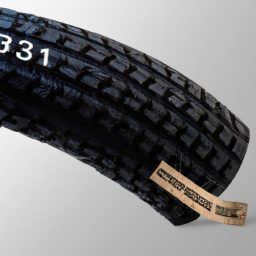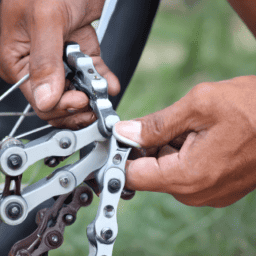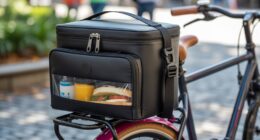Choosing the right size for a bicycle can seem overwhelming, particularly for those who are purchasing for the first time. The vast array of models and designs out there makes it challenging to even know where to begin. Yet, selecting the correct size for your bike is essential for a ride that’s both comfortable and safe.
Firstly, it’s important to understand that there is no one-size-fits-all solution when it comes to bikes. Everyone’s body is different, and there are a variety of factors that can affect how a bike fits. That’s why it’s essential to measure your height and inseam length accurately and determine your riding style before choosing a bike size.
In this article, I’ll guide you step-by-step through the process of sizing a bike so that you can find the perfect fit for your needs.
Key Takeaways
- Height and inseam length are crucial measurements for determining bike size.
- Posture and standover height also play a role in bike sizing.
- Different types of bikes are designed for different riding styles and terrain.
- Test riding your bike and adjusting components can help ensure a comfortable and safe fit.
Measure Your Height
To measure your height, you’ll need to stand up straight against a wall. It’s important to ensure the proper fit of your bike, so it feels like an extension of your body. Posture is crucial during this step.
Stand up straight with your feet together and your back against the wall. Make sure that your head, shoulders, and hips are touching the wall. Also, ensure that your eyes are looking straight ahead. Avoid common mistakes such as slouching or leaning forward. These mistakes can throw off your measurement and lead to an incorrect bike size.
Once you’ve measured your height, the next step is to measure your inseam length. This measurement is crucial since it determines the standover height. The standover height is the clearance between the top tube of the bike and your crotch.
With this information, you can begin to narrow down your bike options and find the perfect fit for your body.
Measure Your Inseam Length
Simply measure the length from the ground to your crotch, and voila – you’ll have the key to unlocking the perfect fit for your two-wheeled companion. This is known as your inseam length, and it is essential in finding accurate measurements when sizing a bicycle. Getting the correct inseam length is crucial as it determines the standover height, which is the distance between the top tube of the bike frame and your crotch.
To find your inseam length, stand barefoot with your feet shoulder-width apart, and place a book between your legs, up against your crotch. Measure the distance from the floor to the top of the book. You can also use online calculators to determine your inseam length accurately. Once you have your inseam length, you can refer to a size chart to find the right bike size that corresponds with your inseam. Now that you have this measurement, you can move on to determining your riding style.
Note that the inseam length alone is not enough to determine the perfect fit for your bike. Other factors such as your riding style, preferred handlebar position, and frame geometry also come into play. With the inseam length as your starting point, you can now consider these other factors and find the ideal bike size for your needs.
Determine Your Riding Style
When it comes to choosing a bike, it’s important to determine your riding style.
As someone who’s passionate about cycling, I know that there are several types of bikes to consider, each with unique features and benefits.
Road bikes are designed for speed and efficiency on smooth, paved surfaces, while mountain bikes are built for rugged terrain and off-road adventures.
Hybrid bikes offer a blend of both styles, and there are also other types of bikes to explore depending on your needs and preferences.
Road Bikes
Riding a sleek road bike down a winding road, feeling the wind in your hair and the hum of the tires on the pavement, requires the right fit to ensure comfort and efficient power transfer.
Choosing the right road bike size is crucial for a comfortable and efficient ride. The size of a road bike is determined by its frame size, which is measured from the center of the bottom bracket to the top of the seat tube.
When selecting a road bike, it’s important to consider your inseam and height to ensure the proper fit. Tips for improving road bike fit include adjusting the saddle height, positioning the handlebars and brake levers to fit your reach, and ensuring the frame size is correct for your body type.
A proper fit will not only improve comfort, but also increase your power and efficiency on the bike.
As we move on to discussing mountain bikes, it’s important to note that fit is just as important for this type of bike, but there are additional factors to consider.
Mountain Bikes
Get ready to hit the trails with a mountain bike that fits your body and riding style. When sizing a mountain bike, it’s important to consider the terrain you’ll be riding on and the type of riding you’ll be doing.
Mountain bike tires come in different widths and treads for different types of terrain. For example, wider tires with aggressive treads are better for loose or muddy terrain, while narrower tires with smoother treads are better for hard-packed trails.
Choosing the right suspension is also crucial for a comfortable and efficient ride. Full suspension mountain bikes have both front and rear suspension, providing a smoother ride on rough terrain. Hardtail mountain bikes have only front suspension, making them lighter and more efficient on smoother terrain.
It’s important to test ride different types of suspension to find what works best for your riding style and the terrain you’ll be riding on.
Now, let’s move on to the next section about hybrid bikes.
Hybrid Bikes
Hybrid bikes offer the perfect combination of speed and comfort for urban commuting and light trail riding. If you’re looking to purchase one, here are some hybrid bike features to consider:
-
Frame: Look for a lightweight frame made of aluminum or carbon fiber. These materials make it easier to maneuver the bike and provide a smoother ride.
-
Tires: Hybrid bikes usually come with wider tires than road bikes for added stability and comfort. Look for tires with a good tread for better traction on different surfaces.
-
Suspension: Some hybrid bikes come with front suspension forks, which absorb shocks and make the ride more comfortable. However, they can add weight and reduce efficiency.
When choosing the right hybrid bike model, consider your riding style and needs. Do you need a bike for daily commuting or weekend adventures? Are you looking for a faster or more comfortable ride? Take the time to test ride different models and ask questions to find the perfect fit for you.
Moving on to other types of bikes, it’s important to note that each one has its own unique features and benefits.
Other Types of Bikes
Exploring different types of bikes opens up a world of possibilities for your cycling adventures. Electric bikes are gaining in popularity due to their ease of use and ability to cover longer distances without the need for excessive physical exertion. These bikes are equipped with a motor that assists with pedaling, making them ideal for commuting to work or running errands around town. Folding bikes offer a convenient and space-saving option for those who have limited storage space. These bikes can be easily folded up and stored in a closet or trunk of a car, making them ideal for those who want to take their bike on public transportation or travel with their bike.
To better understand the differences between these types of bikes, refer to the table below.
| Bike Type | Features | Best Use |
|---|---|---|
| Electric Bike | Motor-assisted pedaling, rechargeable battery | Commuting, leisurely rides |
| Folding Bike | Compact size, easy to store and transport | Travel, public transportation |
When choosing the right bike for your needs, consider your intended use and storage space. Electric bikes and folding bikes offer unique features that may be better suited for certain situations. To ensure a proper fit for your chosen bike, refer to the next section on how to use a bike size chart.
Use a Bike Size Chart
When determining the right size for a bicycle, it’s important to understand bike size measurements and know how to use the correct bike size chart.
The bike size chart is a helpful tool that takes into account a variety of factors such as height, inseam length, and riding style to determine the appropriate bike size for an individual.
By using the right chart and understanding the measurements, you can ensure that your bike fits you correctly and provides a comfortable and safe riding experience.
Understanding Bike Size Measurements
To get the best fit for your bike, it’s important to understand the size measurements. Common bike sizing mistakes include assuming that all bikes are the same size and not adjusting the bike fit to your body.
Bike size measurements are typically based on the length of the seat tube and the length of the top tube. The seat tube measurement is the distance from the center of the bottom bracket to the top of the seat tube. The top tube measurement is the distance from the center of the seat tube to the center of the head tube.
It’s important to note that bike sizing can vary between manufacturers and models, so it’s essential to try out different sizes and styles to find the best fit for you. Once you have the correct bike size measurements, you can adjust the bike fit to ensure maximum comfort and efficiency while riding.
Understanding bike size measurements is the first step towards finding the perfect bike fit. With this knowledge, you can move on to using the correct bike size chart to make sure you’re selecting the right size for your needs.
Using the Correct Bike Size Chart
Sure, because you already know everything about bike sizing, you won’t need any help from a bike size chart. But for those who are not as knowledgeable, using a bike size chart can be incredibly helpful in finding the right fit. The importance of proper sizing cannot be overstated as it can greatly impact your comfort, performance, and overall experience while riding.
When using a bike size chart, it’s important to remember that different manufacturers may have slightly different sizing measurements. It’s best to use the size chart provided by the specific bike brand you are interested in to ensure the most accurate fit. Here’s an example of a bike size chart from one of the most popular bike brands, Trek:
| Height (ft/in) | Inseam (in) | Frame Size (cm) |
|---|---|---|
| 5’0"-5’2" | 27"-29" | 49-50 |
| 5’2"-5’4" | 29"-31" | 51-52 |
| 5’4"-5’5" | 30"-32" | 53-54 |
| 5’5"-5’7" | 31"-33" | 54-55 |
Using this chart, someone who is 5’6"with a 32"inseam would likely need a frame size of 54-55cm. By following the chart and finding the appropriate size, you can ensure the best possible fit for your body and riding style.
It’s important to note that while using a bike size chart is a great starting point, it’s not a substitute for actually test riding your bike. This will allow you to assess the fit and make any necessary adjustments to ensure maximum comfort and performance.
Test Ride Your Bike
Experience the thrill of the ride by taking your bike for a spin and feel the wind in your hair. Test riding your bike is an essential step in determining if the bike size is right for you.
Here are some things to keep in mind when test riding your bike:
-
Pay attention to your comfort level. Are you able to sit on the bike comfortably and ride without any discomfort or pain? If not, it may be a sign that the bike size is not right for you.
-
Adjust the components to your liking. Try adjusting the seat height, handlebars, and pedals to see if you can find a more comfortable riding position. This can help you determine if the bike size is right for you or if you need to try a different size.
-
Take the bike for a test ride on different terrains. This can help you get a better feel for how the bike handles and if it is the right fit for your riding style.
It’s important to remember that finding the right bike size is crucial for your comfort and safety while riding. By test riding your bike and paying attention to your comfort level and adjusting components, you can ensure that your bike is the right size for you.
Frequently Asked Questions
What is the weight limit for a bike size?
When determining the weight limit for a bike size, proper weight distribution is crucial. The impact of terrain on weight limit must also be considered. As a knowledgeable cyclist, I always prioritize safety and follow manufacturer guidelines for weight limits.
How do I know if a bike is too heavy for me?
If a bike is too heavy, it can be difficult to handle and cause fatigue. However, riding a heavy bike can help build endurance. Pros and cons should be weighed before choosing a heavier bike.
Do different bike brands have different sizing charts?
Yes, bike brand comparison can present fitting challenges due to varying geometry and sizing charts. It’s important to research the specific brand’s chart and consult with a professional to ensure proper fit.
Can I adjust the bike size to fit me better?
Adjusting fit is essential for comfort and efficiency. Proper bike sizing is crucial for injury prevention and optimal performance. Using adjustable components such as stem length and saddle position can help achieve a better fit.
How do I choose the right type of bike for my needs?
To choose the right bike, consider the terrain and riding style. Mountain bikes are great for off-road adventures, while road bikes are ideal for speed. When choosing a kid’s bike, ensure proper size for safety and comfort.
Conclusion
In conclusion, sizing a bicycle is a crucial process that requires precision and attention to detail. Much like fitting a puzzle piece perfectly, finding the right size bike involves measuring your height and inseam length, determining your riding style, and using a bike size chart.
It’s like getting fitted for a tailored suit – the right measurements ensure a comfortable and efficient ride. Picture your ideal bike as a well-tuned instrument. Each component must be in harmony with one another to create a symphony of motion.
The wrong size bike can throw off this balance, making your ride uncomfortable and causing unnecessary strain on your body. However, with the right size bike, you can achieve a seamless and effortless ride, allowing you to fully enjoy the beauty of the journey.
So, take the time to size your bike properly and get ready to hit the road with confidence.

